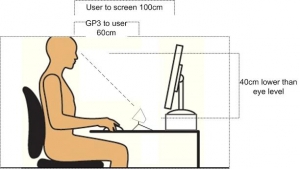Whether you’re exploring eye-tracking for the first time or researching how Gazepoint’s eye-tracking technology could apply to your business, you can find answers here. Explore common questions and learn what eye-tracking can do, and then order your affordable, research-grade eye-tracker from Gazepoint today.
How much does an eye tracker cost?
Some eye trackers can cost tens of thousands of dollars, but here at Gazepoint, we believe in providing our cutting-edge, easy-to-use technology at a consumer price point. Explore our affordable options and order a bundle to receive all the hardware and software you need for your project.
What is eye tracking used for?
Eye-tracking is applied to a number of industries, from marketing and usability research to medicine and adaptive technology. You can learn how Gazepoint eye-tracking technology is used by visiting our applications page, our publications collection, or our blog. If you are interested in trying the best eye-tracking software for marketers and more, explore our options on our shop page!
What can eye tracking tell us?
Eye-tracking offers unparalleled insight into what a user is thinking. Researchers can extrapolate a lot of data from how long a user looks at a certain section, how they navigate a page and more. Combined with biometric sensors, researchers can even estimate how a user feels as they browse online content.
What does an eye tracker do?
The Gazepoint eye tracker records data on where a user looks on a webpage, using infrared light to track the movement of an individual’s pupils. Researchers can also measure how long a user spends looking at a specific area.
With Gazepoint software, it is possible to visualize not only an individual’s gaze path, but also the relationship between metrics like fixations and areas of interest.
How do you utilize eye tracking at home?
Visit our tutorials or downloads page for support on how to set up and use your Gazepoint eye-tracking technology.
Tips:
1. The GP3 needs to be around 65 cm (25 inches) or around an arm’s length from the user’s face
2. The GP3 should ideally be around 40 cm (15 inches) lower than the user’s eye level so it can point at an upwards angle towards the eyes, avoiding reflection from infrared light.
3. For a 19-inch monitor, the GP3 should be around 15 cm (6 inches) in front of the bottom of the monitor. For smaller monitors, it should be closer, and it should be positioned further away for larger monitors while maintaining the arm’s length distance from the user to the eye tracker.
4. Avoid bright lights (or sunlight) pointing at the GP3 or the user’s face — the GP3 will work in a dark room.
5. If the user is wearing glasses, bring the GP3 slightly closer to the user and point up towards the user’s eyes at a steeper angle than usual.
Video – .avi
Still image – .png
Intel Core i5 – 8th generation processor or higher
8 GB RAM minimum
We generally take one business day to prepare your shipment and dispatch it.
Transit to the U.S. and Canada ~ 2 days
Transit to the E.U. ~ 3 days
Transit to other European countries ~ 4–5 days
Transit to South America ~ 4–5 days
Transit to Asia ~ 4–5 days
Transit to the Middle East ~ 5–6 days



